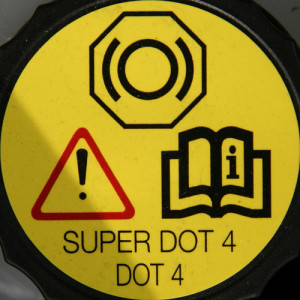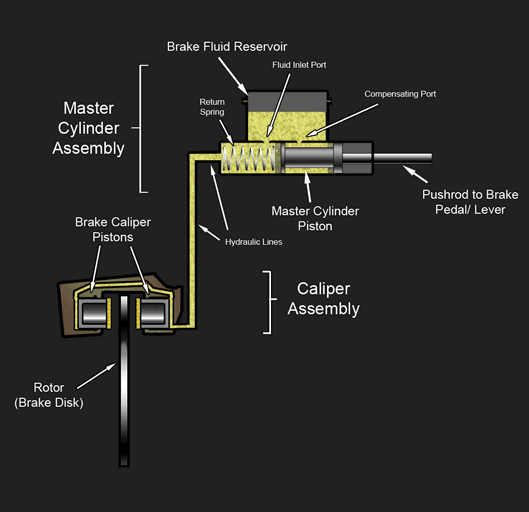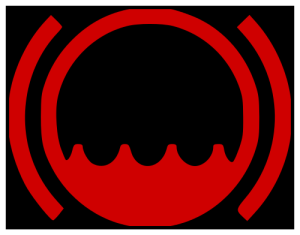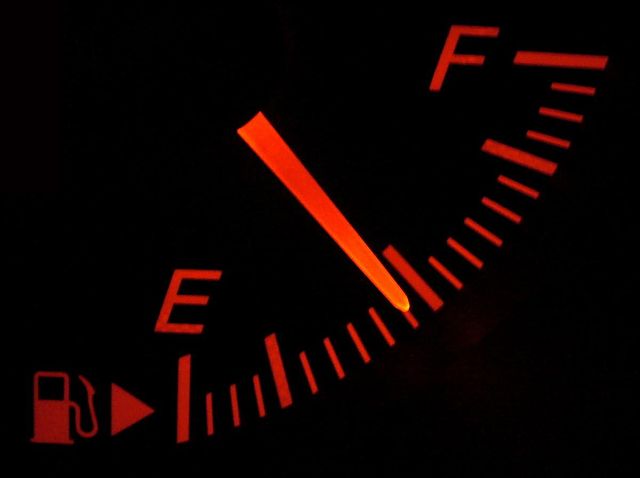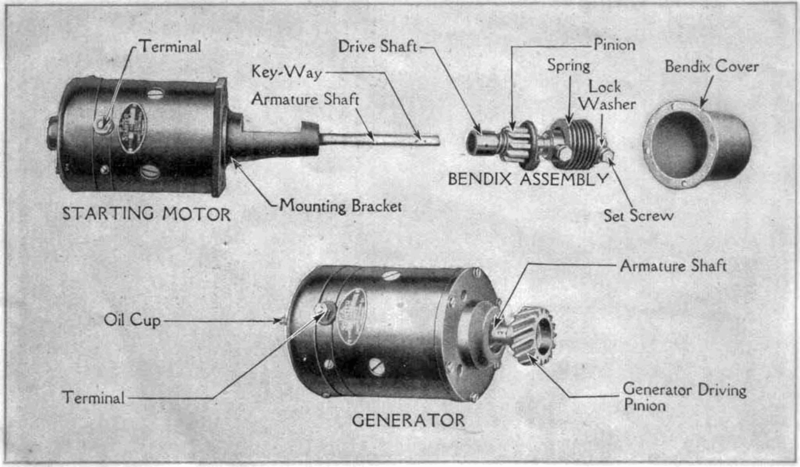What is Brake Fluid?
Brake fluid is a liquid that is used to transmit hydraulic pressure in brake systems. The first automobiles used mechanical brakes, but hydraulic brakes were devised very early on. Since then, a number of different types of brake fluid have been used in hydraulic brake systems that have undergone a series of iterative changes over the years. Today, most automotive brake fluid is either glycol- (DOT3) or silicone-based (DOT5).
Regardless of the specific type, brake fluid has to have a number of characteristics in order to function properly in real-world automotive applications. It has to have a high boiling point, be non-corrosive, exhibit relatively little compressibility, and maintain a relatively constant level of viscosity.
If any air or moisture is ever present in a brake hydraulic system, these characteristics can be severely compromised, which is why brake fluid has to be changed regularly and bled of air whenever the integrity of the system is broken.
Contents
The History of Brake Fluid
The first automobiles used mechanical brakes, but hydraulic systems were developed relatively early on. The first hydraulic system was devised in 1914 by American automotive pioneer Frederick Duesenberg, and Lockheed Corporation co-founder Malcolm Lougheed developed his own system in 1918.
Early brake fluids included castor oil-based hydraulic fluids and alcohols. Some of the alcohols that were used included butanol and ethanol. These substances were used prior to brake fluid regulations were established, and the DOT 2 standard provides for oil-based brake fluid.
Glycol-based brake fluids were the next to appear, and the DOT 3, 4, and 5.1 standards describe the specifications that they have to meet. Silicone-based fluids were the most recent development in the history of brake fluid, but they aren’t as widely used.
Types of Brake Fluid
Modern brake fluid can be broken down into three basic categories:
- oil-based
- glycol-based
- silicone-based
In the United States, these three basic types of brake fluid are broken down further based on a number of specifications that are dictated by the US Department of Transportation. Since these specs are determined by the Department of transportation, they are referred to as “DOT numbers.”
DOT 2 Brake Fluid
DOT 2 brake fluid is oil-based, and it isn’t widely used in the automotive industry. It has the lowest wet and dry boiling points of all the brake fluids. If your vehicle calls for Dot 3, 4, or 5 fluid, you shouldn’t add DOT 2 fluid.
DOT 2 Boiling Points
- DOT 2 “dry” boiling point: 190 °C (374 °F)
- DOT 2 “wet” boiling point: 140 °C (284 °F)
DOT 3, 4, and 5.1 Brake Fluid
DOT 3, 4, and 5.1 brake fluids are all glycol-based, which means they are all somewhat compatible with each other. Most vehicles that were produced or sold in the US prior to 2006 use DOT 3 brake fluid, and most vehicles produced or sold in the US after that date use DOT 4.
The boiling points of these fluids varies, with DOT 5.1 having the highest boiling point, DOT 3 the lowest, and DOT 4 sitting between the two. The viscosity of glycol-based brake fluids follows the same pattern, with DOT 5.1 having the lowest viscosity and DOT 3 having the highest.
Although glycol-based brake fluids are all relatively “compatible,” a good rule of thumb is to never put in a lower DOT number than the system calls for. A system that calls for DOT 3 fluid will work with DOT 4 fluid, but a system that calls for DOT 4 may malfunction if DOT 3 fluid is added due to the lower boiling point.
In any case, DOT 5 (silicone-based) brake fluid should never be added to a system that calls for DOT 3, 4, or 5.1 brake fluid.
All glycol-based brake fluids are somewhat hygroscopic, which means that they tend to absorb water from the atmosphere. This is one of the reasons that it’s important to flush brake fluid on a regular basis, since excessive water can cause corrosion and poor braking.
DOT 3, 4, and 5.1 Boiling Points
- DOT 3 “dry” boiling point: 205 °C (401 °F)
- DOT 3 “wet” boiling point: 140 °C (284 °F)
- DOT 4 “dry” boiling point: 230 °C (446 °F)
- DOT 4 “wet” boiling point: 155 °C (311 °F)
- DOT 5.1 “dry” boiling point: 260 °C (500 °F)
- DOT 5.1 “wet” boiling point: 180 °C (356 °F)
DOT 5 Brake Fluid
DOT 5 brake fluid is silicone-based, which means it isn’t compatible with any other type of brake fluid. The main advantage of this type of brake fluid is that it is hydrophobic, which means it doesn’t readily mix with water. It also has a higher boiling point than either DOT 3 or 4 fluid, and the same viscosity and boiling point as DOT 5 fluid. It also won’t damage paint, which glycol-based fluids tend to do.
Although DOT 5 brake fluid has a number of positive factors going for it, its compressibility can suffer if it absorbs too much air. This air is held in solution, which isn’t the same as the air bubbles that you can remove with a proper bleeding procedure. In some cases, repeated bleeding can remove more air as it works its way out of solution.
DOT 5 Brake Fluid Boiling Points
- DOT 5.1 “dry” boiling point: 260 °C (500 °F)
- DOT 5.1 “wet” boiling point: 180 °C (356 °F)
How Does Brake Fluid Work?
Brake fluid works by transmitting hydraulic pressure from a brake master cylinder to slave cylinders that are located at each wheel. When a brake pedal is pressed, it actuates a master cylinder push rod, which may or may not be assisted by a power brake booster. This push rod then causes the brake master cylinder to generate hydraulic pressure, which is transmitted through a closed system via metal brake lines.
In drum brakes, the hydraulic pressure generated by the master cylinder causes wheel cylinders to push brake shoes against brake drums. In disc brakes, the pressure is used by brake calipers to pinch brake discs between brake pads.
In order to perform this function, brake fluid has to possess a number of vital characteristics, including:
- low compressibility
- constant viscosity
- noncorrosive
- high boiling point
Brake Fluid Compressibility
Compressibility is an important factor in brake fluid due to the way that hydraulic brake systems work. When the brake pedal is depressed, the master cylinder is activated a single time, which generates pressure throughout the closed hydraulic system. If brake fluid compresses too much, the master cylinder may not be capable of generating enough pressure to activate the brakes.
Brake Fluid Viscosity
In terms of viscosity, or how easily brake fluid flows, it is important that it remain at a relatively constant level over a variety of temperatures. The viscosity of fluids tends to change depending on how hot or cold it is, and brake fluid can exhibit a wide range of temperatures depending on how hot (or cold) it is outside, and how heavily the driver uses the system. If the viscosity changes too much, especially in systems that use anti-lock brakes, the brake system won’t work properly.
Brake Fluid Corrosion
Since brake fluid is in constant contact with metal components like brake lines, master cylinders, and slave cylinders, it is imperative that it not corrode those components. Although neither glycol- or silicone-based brake fluids are corrosive by nature, moisture can cause corrosion if it is able to enter the system. This can be an issue with systems that use glycol-based brake fluid, since it tends to absorb moisture from the atmosphere.
Brake Fluid Boiling Point
The boiling point of a brake fluid may be its most vital characteristic. Brake fluid tends to get hot during operation due to heat transfer from the brakes (which function largely by converting kinetic energy into heat energy), and brakes can fail if the fluid boils.
In the United States, the DOT standards each provide minimum dry and wet boiling points for each type of brake fluid. Castor oil-based fluids (DOT 3) have the lowest boiling points, and silicone-based fluids (DOT 5) have the highest. Although glycol-based DOT 5.1 fluid has the same boiling point as DOT 5, the more common DOT 3 and Dot 4 fluids have lower boiling points.
Brake Fluid Service and Maintenance
Throughout the course of normal vehicle operation, brake fluid can become contaminated with water, air, and broken-down materials from seals and other internal brake system components. The two different procedures that can be used to fix these situations are bleeding and flushing, which both involve removing some amount of brake fluid and replacing it with fresh fluid.
Brake Fluid Bleeding
Brake fluid bleeding can be accomplished with or without special equipment. In situations where the fluid is clean, but air has gotten into the system, it is possible to bleed a brake system manually. The steps in this process are:
- Check to ensure the brake master cylinder is full.
- Have a helper firmly depress the brake pedal.
- Loosen the bleeder screw on one of the calipers or wheel cylinders.
- Catch the fluid that leaves the bleeder screw in a pan, and look for signs of air bubbles in the stream.
- Tighten the bleeder screw.
- Have your helper release the brake pedal.
This process can be repeated as many times as necessary in order to remove all of the air from the system. If it doesn’t work, or the fluid is dirty, you can use a vacuum brake bleeder to accomplish the procedure without a helper. In that case, it’s also a good idea to suck the dirty fluid out of the master cylinder first and replace it with clean fluid.
Brake Fluid Flushing
The other method of servicing brake fluid requires a flushing device. These devices vary in design, but they are essentially designed to force clean brake fluid through the hydraulic system in order to remove both air and dirty fluid. The steps in brake fluid flushing include:
- Suck the dirty fluid out of the brake master cylinder reservoir.
- Attach the flushing device to the brake master cylinder reservoir with the appropriate adapter.
- Activate the flushing device so that it applies pressure to the system.
- Loosen one bleeder screw at a time, catching the fluid in a pan and watching for signs of air and dirty fluid.
- After each wheel has been bled, shut off the flushing device and test the brake pedal.
Some vehicles have special flushing procedures, in which case you may have to bleed the wheels in a specific order or activate a valve in order to remove all of the air from the system. In any case, it is imperative that you verify the proper operation of the brakes before reassembling and test driving the vehicle.
Low Brake Fluid
Some vehicles have a warning light on the instrument cluster that indicates low brake fluid, and others require regular visual inspection of the master cylinder reservoir. In either case, low brake fluid can indicate one of two things. In most cases, low fluid simply indicates that the brakes are wearing normally, which results in displacement of the pistons in the calipers and more “space” in the hydraulic system. If that is the case, then you should simply add the appropriate type of brake fluid in order to top off the reservoir.
If low brake fluid is accompanied by a pedal that feels soft, fades, or sinks to the floor, then you may have brake system problems. In that case, you will need to perform a visual inspection of all the hydraulic system components to check for leaks, or take your vehicle in to a professional automotive technician for inspection.


